
HQS Wellington
HMS Wellington (launched Devonport, 1934) is a Grimsby-class sloop, formerly of the Royal Navy. During the Second World War,
she served as a convoy escort ship in the North Atlantic. She is now moored alongside the Victoria Embankment, at Temple Pier, on
the River Thames in London as the headquarters ship of the Honourable Company of Master Mariners where she is known as
HQS Wellington. It was always the ambition of the founding members of the company to have a livery hall. Up to the outbreak of
war in 1939, various proposals were examined, including the purchase of a sailing ship, the Archibald Russell.
After the war, it became apparent that the possibility of building a hall in the City of London had been rendered very remote. In
1947, the Grimsby-class sloop Wellington was made available by the Admiralty. The company decided to buy her with money
subscribed by the members and convert her to a floating livery hall - an appropriate home for a company of seafarers.
Before the Second World War HMS Wellington served in the Pacific mainly on
station in New Zealand and China. As built, Wellington mounted two 4.7 inch guns
and one 3-inch gun. Additionally, anti-aircraft guns were fitted for self-defence.
Depth charges for use against submarines were carried. Wellington served
primarily in the North Atlantic on convoy escort duties. She shared in the
destruction of one enemy U-boat and was involved in Operation Dynamo, the
evacuation of troops from Dunkirk. A fuller account of Wellington’s war service has
been written by Captain A. D. Munro in his book HMS/HQS Wellington.
During
1943 she was briefly commanded by Captain John Treasure Jones, at that time a
lieutenant commander in the Royal Navy Reserve, who would later be the last
captain of RMS Queen Mary.
The Grimsby-class anti-submarine sloops of 1933-36, which included HMS Wellington, were the predecessors of the famous Black
Swan sloops of 1939, including HMS Starling which sank 14 U-boats, and HMS Amethyst, the hero of the 1949 Yangste Incident.
These wartime sloops further evolved during the Battle of the Atlantic into the River and Loch-class ASW frigate types.
HMS President is moored near Wellington on the Embankment. This ship, built as HMS Saxifrage in 1918, was a Flower-class anti-
submarine Q-Ship, and is one of the last three surviving warships of the Royal Navy built during the First World War. President was
one of the first types of warship built specifically for anti-submarine warfare. Wellington and President together represent the first
and second generation ancestors of modern frigates, which are the most numerous type of front-line warship in today's navy.
In naval fiction.
After the War, she was converted from being His Majesty’s Ship Wellington to
"Head Quarters Ship" HQS Wellington at Chatham Dockyard. The cost of this
conversion was met by an appeal to which Lloyd's, Shipping Companies,
Livery Companies and many other benefactors generously contributed. It
included the installation of a grand wooden staircase taken from the 1906 Isle
of Man ferry SS Viper, which was being broken up at the same time.
Wellington arrived at her Victoria Embankment berth in December 1948 to
continue service as the floating livery hall of the Honourable Company of
Master Mariners.
In 1991, HQS Wellington was dry-docked at Sheerness for three months during which, apart from extensive steelwork repairs and
complete external painting, she received a major refurbishment which included the refitting of all toilet facilities, offices and
accommodation areas. For the first time, Wellington was fully fitted with custom-made carpet, and displays were installed of the
Company’s marine paintings and artefacts, gold and silver plate, ship models and newly discovered very early 18th century charts.
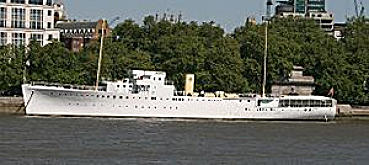
HQS Wellington as she is today
Post-war
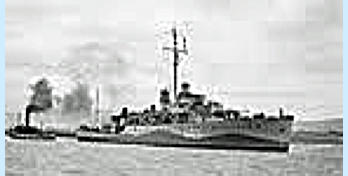
HMS Wellington in April 1942
Naval Service
The Wellington Trust
On the 1st of July 2005 ownership of the Wellington was transferred from the Honourable
Company to the Wellington Trust, a charitable trust established to ensure the preservation of
this historic ship.
Moored opposite Temple Underground Station, HQS
Wellington is centrally located straddling the boundary
between The City and Westminster. It is very popular for
lunches, dinners, and conferences for parties up to 250
people. Wellington is a unique London venue for any
functions which benefit from the backdrop of its
wonderful collection of marine antiques, including
priceless paintings and model ships.
Flexibility is key to the attraction of this venue with a range of rooms available, from small
meetings in a boardroom to a whole ship event. The ship is also a licensed venue for holding
weddings.
The library onboard the Wellington contains numerous publications on a variety of maritime subjects, ranging from the complete
works of Joseph Conrad to Lloyd’s Register of ships. In addition, there are many ship’s log books, first hand accounts of seafaring
and empirical research papers. The library also contains a large collection of sextants, chronometers and other maritime
instruments and artefacts. Of particular importance is a rare Listor & Martins Berlin circular sextant made in Germany in the mid
19th Century and a French Chronometer built by Berthoud and dating from the 1850s.
The Wellington houses a wide range of beautiful and historic artefacts and treasures onboard, including a large collection of ship
models, which include a large model of HMS Victory, an exquisitely detailed model of the Cutty Sark and a model of a whaler made
from whale bone. In 2005, the Honourable Company lent a number of artefacts to the Museum of Garden History for an exhibition
on Captain (later Vice Admiral) Bligh’s epic voyage 3618 mile voyage, following the mutiny onboard the HMAV Bounty
Medals won by a number of Company members are also displayed. These include two George Cross’ won by Captains GP
Stronach and DM Mason and one Victoria Cross won by Captain RB Stanard RN.
The ship is open to visitors on occasions throughout the year and group tours can also be arranged at a nominal cost, to include
refreshments. The ship is located just across the road from Temple tube station (on the District / Circle Lines), a 10 minute walk
from either Charing Cross or Blackfriars mainline stations, or 15-20 minutes across the Thames from Waterloo.
As HQS Wellington is a working environment, it is not open to the public except on specified days, but students of maritime history
and those interested in the sea are most welcome to visit us by appointment;
For further information visit: http://www.thewellingtontrust.com
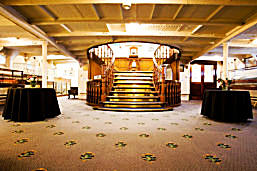
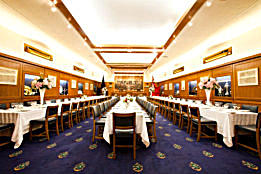

The SS Shieldhall was laid down in October 1954, launched on 7th July 1955 and entered service in October of that year. Built by
Lobnitz & Co., of Renfrew on the River Clyde to a specification determined by the Glasgow Corporation, she was required to carry
her “cargo” as well as passengers housed in a spacious saloon in her daily trips “doon the watter”.
Shieldhall was operated by Glasgow Corporation to transport treated sewage sludge down the river Clyde to be dumped at sea. She
continued a tradition, dating back to the First World War, that Glasgow's sludge vessels carried organised parties of passengers
when operating during the summer months. Thus Shieldhall was built with accommodation for 80 passengers.
In 1976, after 21 years of faithful service on the Clyde, Shieldhall was laid up. Shieldhall was purchased by the Southern Water
Authority in 1977. For five years, from 1980, she carried sludge from Marchwood, Millbrook and Woolston in Southampton to an area
south of the Isle of Wight. It was when she was suddenly withdrawn from service in July 1985, due to rising fuel prices, that active
preservation began.
As a result of an initiative by the Southampton City's Museum Services, a preservation society was formed and "Shieldhall" was
purchased from Southern Water in 1988, for £20,000. The Society is registered as an Industrial and Provident Society as The
Solent Steam Packet Limited and operates as a charity.
All work associated with the Society and "Shieldhall" is carried out by unpaid volunteers. Much work has been done on the ship by
these volunteers in order to keep her in sea-going condition. The saloon has been restored and the galley brought up-to-date.
Crewed by volunteers, "Shieldhall" is a frequent sight around the Solent running excursions and such like. She has been to Holland
for the Dordrecht Steam Festival and she has been an attendee at each of the International Festivals of the Sea at Bristol and
Portsmouth.
During the summer months, various excursions are run in the Solent area and during the course of these voyages, passengers are
encouraged to visit the Bridge and machinery spaces.
“Shieldhall” is unique as a time capsule providing a working example of steamship machinery both above and below deck, typical of
the cargo and passenger ships that plied the oceans of the world from the 1870s until the mid 1960s, by which time they were all but
extinct.
The ship is of special interest as she is built on the classical lines of a 1920s steamer with a traditional wheelhouse; the hull is of
riveted and welded construction and this unusual feature is representative of the transitional phase in British shipbuilding when
welding took over from riveted practice. The hull has a slightly raked bow and cruiser stern. The teak decks and emergency steering
position aft add to the classic effect. Shieldhall was effectively obsolete mechanically at the time of her launch having steam
machinery representative of the late 19th century at a time when the diesel engine was coming into its own. She is now believed to
be the largest working steam ship in Northern Europe.
For further information visit: http://www.ss-shieldhall.co.uk
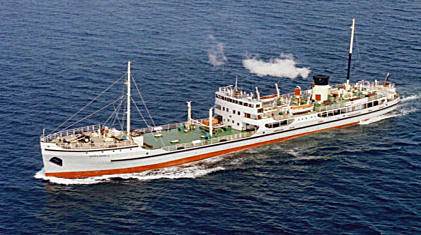
FEATURED ARTICLES
Page 1 of 6

History
PS Waverley is named after Sir Walter Scott's first novel. She was built in 1946 to
replace a PS Waverley that was built in 1899, served in the Second World War as a
minesweeper and was sunk in 1940 while helping to evacuate troops from Dunkirk.
Shipbuilders A. & J. Inglis of Glasgow launched the new 693 tonne steamer in
October 1946. She entered service with the London and North Eastern Railway in
June 1947, working the LNER's Firth of Clyde steamer route from Craigendoran Pier,
near Helensburgh, up Loch Long to Arrochar. In her first year in service she wore that
company's red, white and black funnel colours.with red lions and yellow funnels in
1970
The 1948 nationalisation of Britain's railways brought their Scottish steamers into the
Caledonian Steam Packet Company (CSP), a subsidiary of the Railway Executive,
and the funnels were repainted yellow with a black top. In 1965 a Scottish red lion
rampant was fixed to each side of both funnels. Waverley 's hull was painted
monastral blue until 1970.
After a revival of fortunes in the 1950s, the 1960s saw a gradual change in holiday habits that led to a decline in passenger numbers
and the closure of many of the small piers. Since 1969 and the formation of the Scottish Transport Group, the CSP had been
gradually merging with the West Highland shipping and ferry company David MacBrayne Ltd. In 1973 the company became
Caledonian MacBrayne Ltd (CalMac).
Restoration
CalMac withdrew Waverley after the 1973 season as she was too costly to operate and
needed significant expenditure. By then the Paddle Steamer Preservation Society had
been set up as a registered UK charity, and had bought the near-derelict small River Dart
paddler PS Kingswear Castle. CalMac, keen to ensure that the ship was preserved, sold
Waverley to the PSPS for the token sum of one pound. Neither side really believed that the
vessel would return to steam but, just in case, Caledonian MacBrayne stipulated that she
should not sail in competition with their remaining cruise vessel, TS Queen Mary.
A public appeal was launched to secure funding for the return of the Waverley to service
and the fund-raising operation was successful. The PSPS found itself running a cruise ship
operation, "Waverley Excursions". Since then Waverley has been joined in the PSPS fleet
by PS Kingswear Castle and MV Balmoral, and has had a series of extensive refits and
much restoration work, including a new boiler and improvements to meet modern safety
standards. She has circumnavigated Great Britain and every year makes extensive
sailings around the country.
Listed as part of the National Historic Fleet between 2000 and 2003, the ship underwent a substantial rebuild and re-boilering at the
shipyard of George Prior at Great Yarmouth, funded principally by the Heritage Lottery Fund. The work, which was done in two
stages, has added many 21st century safety and technological improvements and returned the ship to her original 1946 livery.
In 2009 the ship was affiliated with HMS Defender, having hosted the official dignitary party at Defender 's launch on the River Clyde.
In 2011 the ship was awarded the Institution of Mechanical Engineers 65th Engineering Heritage Award.
Engines
Waverley is powered by a three-crank diagonal triple-expansion marine steam engine
built by Rankin & Blackmore, Engineers, Eagle Foundry, Greenock, Scotland. It is rated
at 2,100 IHP and achieved a trial speed of 18.37 knots (34.02 km/h; 21.14 mph) at 57.8
rpm. Passengers can watch these engines from passageways on either side of the
engine room.
The main crank is solidly attached to both paddle wheels so they cannot turn
independently of each other. The Waverley therefore has a much larger turning circle
than modern ferries.
Appearance
Waverley leaving Greenock
Waverley has had several colour schemes in her life. Early photographs show paddle
boxes painted sometimes white and sometimes black. The gold stripe along the hull is
in some photos and not others. Today Waverley has the LNER 1947 livery of red, white
and black funnels, traditional brown-grained (or "scumbled") superstructure and black paddle-wheel boxes, decorated with gold
lettering on each side.
Early photos show square windows instead of today's portholes. For most of her life the
upper passenger cabins were painted white and had wooden doors; all have had layout
improvements at some time in the ship's life. Sailing in all weathers in salt water can
cause pale brown rust streaks to appear by the end of each season, so cosmetic painting
and improvements are done annually as the ship is dry-docked and checked by the
Department for Transport.
Since 1962, when PS Waverley 's original funnels were renewed, replacement items had
been slightly out of parallel due to their heavier welded steel construction. The problem
was resolved in the 2000–03 refit and her two funnels are now parallel.
Lifeboat arrangements have varied depending on the legislation at the time. Between
1975 and 1980 there was only one traditional lifeboat on the rear deck giving the ship an
unbalanced appearance from the rear.
Service
Today Waverley makes passenger excursions from various British ports. She regularly sails from Glasgow and other towns on the
Firth of Clyde, the Thames, the South Coast of England and the Bristol Channel. She also undertakes private charters and provides
a period setting for television documentaries and movies such as Sherlock Holmes: A Game of Shadows (2011).
Primarily during the summer she is based on the Clyde, operating excursions from Glasgow, Greenock, Largs or Ayr. Her main
timetable is:
Mondays
Glasgow - Largs - Ayr - Girvan - Round Ailsa Craig - Ayr.
Tuesdays
Ayr - Brodick - Millport - Largs - Dunoon - Blairmore - Cruise Loch Long and Loch Goil and return.
Wednesdays
Largs - Rothesay - Tighnabruaich - Tarbert - Cruise Loch Fyne, Arran Coast and return.
Thursdays
Greenock - Helensburgh - Dunoon - Rothesay - Largs - Millport - Brodick - Cruise Holy Isle, Pladda and return.
Fridays
Glasgow - Kilcreggan - Dunoon - Rothesay and return.
Saturdays
Glasgow - Greenock - Helensburgh - Dunoon - Rothesay - Tighnabruiach and return.
Sundays
Different cruises to places such as Lochranza, Campbeltown etc., from Glasgow.
Her Clyde timetable ends at the end of August and Waverley spends 6 weeks between September and October cruising the Bristol
Channel, the Solent and the Thames before returning to the Clyde for two sailings in October.
Incidents
Waverley at the James Watt Dock, Greenock, for a day's repair work on 13 July 2010, with MV Clansman in for more extended
repairs.
On the evening of Friday 15 July 1977, while returning from a cruise and approaching Dunoon pier, Waverley 's steering failed and
she struck the rocks to the south called The Gantocks. Firmly aground and down by the head, the ship was extensively damaged.
There was some doubt about whether or not she would hold together on re-floating but she did, and she was repaired and returned
to service. Her survival was attributed to her heavier than normal post World War II construction which had included provision for
minesweeping gear and a deck gun in case she was ever requisitioned by the Admiralty for use in a future war.
On 15 September 2008 Waverley was involved in minor damage to Worthing Pier. After she berthed and secured lines to pier
bollards, part of the landing stage was dislodged. The ship escaped damage and the only damage to the pier was that a length of
timber was pulled out, but she had to leave without taking on passengers.
On 26 June 2009 Waverley struck the pier at Dunoon, damaging both the ship and the pier. Some 700 people were aboard at the
time, of whom 12 suffered minor injuries. The ship returned to Glasgow, where the damage was assessed. One week later she was
back in service on the Clyde.


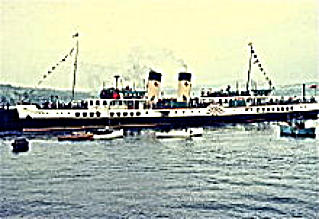
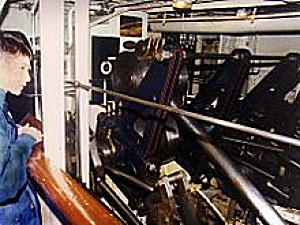
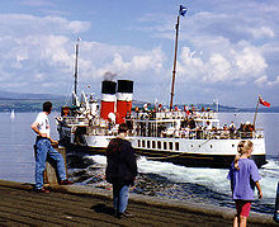

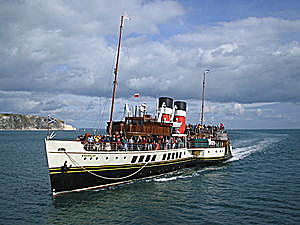


Merchant Navy Association Boat Club
(Affiliated to the Merchant Navy Association National Charity)



Page 1 of 6
